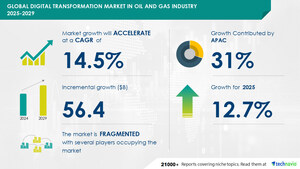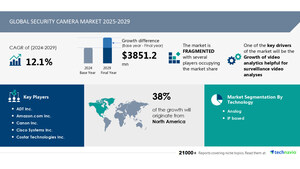NEW YORK, July 5, 2024 /PRNewswire/ -- The global perishable goods transportation market size is estimated to grow by USD 9.23 billion from 2024-2028, according to Technavio. The market is estimated to grow at a CAGR of 8.8% during the forecast period. Rising demand for processed food is driving market growth, with a trend towards adoption of eco-friendly vehicles for transportation of perishable goods. However, safety issues of perishable goods poses a challenge. Key market players include AP Moller Maersk AS, Bay and Bay Transportation, C H Robinson Worldwide Inc., CMA CGM SA Group, Columbian Logistics Network, Compagnie Fruitiere, COSCO Shipping International Co. Ltd., CRST The Transportation Solution Inc., Deutsche Bahn AG, Deutsche Post AG, FST Logistics, Hapag Lloyd AG, Hellmann Worldwide Logistics SE and Co KG, Kuehne Nagel Management AG, Lineage Logistics Holdings LLC, Mitsui and Co. Ltd., Orient Overseas Container Line Ltd., Swift Cargo Pvt. Ltd., VersaCold Logistics Services, and Wincanton Plc.
Get a detailed analysis on regions, market segments, customer landscape, and companies- View the snapshot of this report
Perishable Goods Transportation Market Scope |
|
Report Coverage |
Details |
Base year |
2023 |
Historic period |
2018 - 2022 |
Forecast period |
2024-2028 |
Growth momentum & CAGR |
Accelerate at a CAGR of 8.8% |
Market growth 2024-2028 |
USD 9230.5 million |
Market structure |
Fragmented |
YoY growth 2022-2023 (%) |
7.49 |
Regional analysis |
North America, Europe, APAC, South America, and Middle East and Africa |
Performing market contribution |
APAC at 35% |
Key countries |
US, China, Germany, UK, and India |
Key companies profiled |
AP Moller Maersk AS, Bay and Bay Transportation, C H Robinson Worldwide Inc., CMA CGM SA Group, Columbian Logistics Network, Compagnie Fruitiere, COSCO Shipping International Co. Ltd., CRST The Transportation Solution Inc., Deutsche Bahn AG, Deutsche Post AG, FST Logistics, Hapag Lloyd AG, Hellmann Worldwide Logistics SE and Co KG, Kuehne Nagel Management AG, Lineage Logistics Holdings LLC, Mitsui and Co. Ltd., Orient Overseas Container Line Ltd., Swift Cargo Pvt. Ltd., VersaCold Logistics Services, and Wincanton Plc |
Market Driver
In response to growing environmental concerns, there is a rising trend among shippers to select vendors with minimal carbon emissions in the perishable goods transportation market. Companies like DB Schenker and DHL are spearheading this initiative, transitioning towards the Go Green concept by reducing their carbon footprint through the use of eco-friendly electric vehicles powered by renewable energy. XPO Logistics, with Europe's largest natural gas truck fleet, and DHL's focus on decreasing reliance on fossil fuels in favor of natural gases, are leading the way in green logistics. This approach includes fleet management, green storage and packaging, logistics environment management, alternative fuel implementation, green transportation, and logistics innovation. These actions are expected to boost the adoption of green logistics in the perishable goods transportation sector, driving market growth during the forecast period.
Perishable goods transportation is a vital sector that ensures the timely and safe delivery of temperature-sensitive products like fresh food, fruits, vegetables, meats, poultry, seafood, dairy products, bakery goods, flowers, and other temperature- and moisture-sensitive items. Current trends include stricter regulations to maintain food safety and quality. Technology plays a significant role with RFID tracking systems and advanced technology-based solutions in temperature-controlled containers. Infrastructure developments, such as refrigerated trucks and reefer containers, facilitate efficient transportation via air cargo and sea freights. Consumer preferences for healthier diets, freshness, and convenience drive growth in online supermarkets, meal kits, and meal delivery services. Sustainable practices and e-commerce platforms are also key trends, with the internet and digital platforms enabling seamless ordering and delivery. Overall, the market prioritizes quality assurance and temperature control to meet the demands of health-conscious consumers.
Discover 360° analysis of this market. For complete information, schedule your consultation - Book Here!
Market Challenges
- Perishable goods transportation involves handling sensitive items that are prone to damage and spoilage. To maintain food safety and product quality, these goods must be cooled before transferring to refrigerated trailers or reefers. Direct transfers without cooling can negatively impact the product. Reefers require regular maintenance and sanitization to ensure hygienic conditions. The FDA's 2016 rule mandates documented sanitary practices for food transport, with earlier regulations including the Sanitary Food Transportation Act (2005) and the Food Safety Modernization Act (2011). Temperature regulations exist for various categories of perishable goods. Compliance with these regulations is crucial to prevent food safety issues and ensure market growth.
- The perishable goods transportation market encompasses the movement of temperature-sensitive and moisture-sensitive products, including fruits, vegetables, meats, poultry, seafood, dairy products, bakery goods, flowers, and others. These goods require specialized handling to maintain product quality, safety, and shelf-life. Challenges include spoilage, damage, and degradation, which can lead to foodborne illnesses and wastages. Refrigerated trucks, reefer containers, air cargo, and sea freights are common transportation methods. Cost-effective and efficient services are essential for long-distance trade to ensure customer satisfaction and profit. Processors, couriers, and specialized carriers rely on cold-chain infrastructure, refrigerated transportation equipment, and eco-friendly vehicles like electric vehicles to reduce carbon footprint and promote green transportation. Food safety regulations are crucial to prevent spoilage and maintain product quality throughout the supply chain.
For more insights on driver and challenges - Request a sample report!
Segment Overview
This perishable goods transportation market report extensively covers market segmentation by
- Product
- 1.1 MPS
- 1.2 Dairy
- 1.3 Fruits and vegetables
- 1.4 Bakery and confectionery
- Mode Of Transportation
- 2.1 Road transportation
- 2.2 Air transportation
- 2.3 Others
- Geography
- 3.1 North America
- 3.2 Europe
- 3.3 APAC
- 3.4 South America
- 3.5 Middle East and Africa
1.1 MPS- The global meat production and consumption have seen substantial growth, with meat production reaching 347 million tonnes in carcass weight equivalent in 2022. By 2032, the consumption of poultry, pig meat, beef, and sheep meat is projected to increase by 15%, 11%, 10%, and 15% respectively. Poultry meat is expected to dominate the market, accounting for 41% of total protein consumption from all meat sources. The demand for perishable goods transportation is anticipated to rise due to the increasing consumption in countries like India, Pakistan, the Philippines, Vietnam, and the Sub-Saharan region of Africa. Additionally, global apparent food fish consumption is projected to reach 21.2 kilograms per capita by 2032, driven by the growing awareness of its health benefits. Seafood's rich nutritional value, including omega-3 acids, proteins, and essential vitamins, is fueling this demand. As a result, the Meat, Poultry, Seafood (MPS) segment of the global perishable goods transportation market is poised for growth during the forecast period.
For more information on market segmentation with geographical analysis including forecast (2024-2028) and historic data (2017-2021) - Download a Sample Report
Research Analysis
The Perishable Goods Transportation Market encompasses the transport of temperature-sensitive and moisture-sensitive products, including fruits, vegetables, meats, poultry, seafood, dairy products, bakery goods, flowers, and other fresh food items. Refrigerated trucks, reefer containers, air cargo, and sea freights are the primary modes of transportation used to maintain the required temperature and humidity levels. Processors, couriers, and infrastructure developments play a crucial role in ensuring the quality and freshness of these perishable goods. Regulations, technology, and sustainable practices are key considerations in the perishable goods transportation industry. Consumer preferences for fresh food and health consciousness have driven the demand for temperature-controlled transportation and advanced logistics solutions.
Market Research Overview
Perishable goods transportation refers to the movement of temperature-sensitive and moisture-sensitive products, including fruits, vegetables, meats, poultry, seafood, dairy products, bakery goods, flowers, and other food items. These goods require specialized handling and transportation methods to maintain their quality, safety, shelf-life, and prevent spoilage, damage, and degradation. Refrigerated trucks, reefer containers, air cargo, and sea freights are common modes of transportation used for perishable goods. Product quality, safety, and customer satisfaction are key considerations in perishable goods transportation. Long-distance trade and economic growth are significant drivers of this market. Processed food, ready-to-eat meals, frozen meat, canned vegetables, breakfast cereals, and fresh fruits are also transported using perishable goods transportation methods. Sustainable practices, such as the use of electric vehicles (EVs) and eco-friendly transportation, are gaining popularity to reduce the carbon footprint and promote green transportation. Cold-chain infrastructure, food safety, and regulations are crucial aspects of the perishable goods transportation industry. Specialized carriers, transportation equipment, processors, couriers, and technology play a vital role in ensuring efficient and cost-effective services. Infrastructure developments, temperature-controlled transportation, and sustainable practices are shaping the future of perishable goods transportation. Consumer preferences for health-conscious diets, online supermarkets, delivery services, meal kits, meal delivery services, e-commerce, and digital platforms are driving the demand for advanced technology-based solutions, such as RFID tracking systems and temperature-controlled containers, to ensure the quality and freshness of perishable goods.
Table of Contents:
1 Executive Summary
2 Market Landscape
3 Market Sizing
4 Historic Market Size
5 Five Forces Analysis
6 Market Segmentation
- Product
- MPS
- Dairy
- Fruits And Vegetables
- Bakery And Confectionery
- Mode Of Transportation
- Road Transportation
- Air Transportation
- Others
- Geography
- North America
- Europe
- APAC
- South America
- Middle East And Africa
7 Customer Landscape
8 Geographic Landscape
9 Drivers, Challenges, and Trends
10 Company Landscape
11 Company Analysis
12 Appendix
About Technavio
Technavio is a leading global technology research and advisory company. Their research and analysis focuses on emerging market trends and provides actionable insights to help businesses identify market opportunities and develop effective strategies to optimize their market positions.
With over 500 specialized analysts, Technavio's report library consists of more than 17,000 reports and counting, covering 800 technologies, spanning across 50 countries. Their client base consists of enterprises of all sizes, including more than 100 Fortune 500 companies. This growing client base relies on Technavio's comprehensive coverage, extensive research, and actionable market insights to identify opportunities in existing and potential markets and assess their competitive positions within changing market scenarios.
Contacts
Technavio Research
Jesse Maida
Media & Marketing Executive
US: +1 844 364 1100
UK: +44 203 893 3200
Email: [email protected]
Website: www.technavio.com/
SOURCE Technavio

WANT YOUR COMPANY'S NEWS FEATURED ON PRNEWSWIRE.COM?
Newsrooms &
Influencers
Digital Media
Outlets
Journalists
Opted In





Share this article